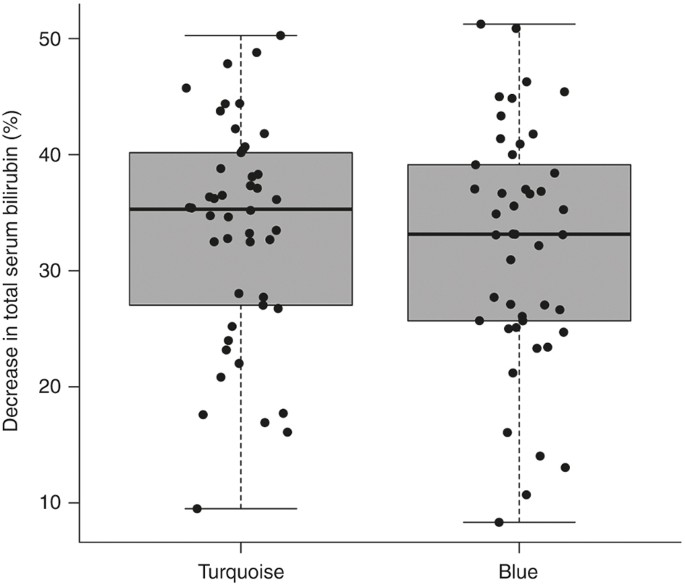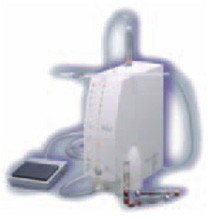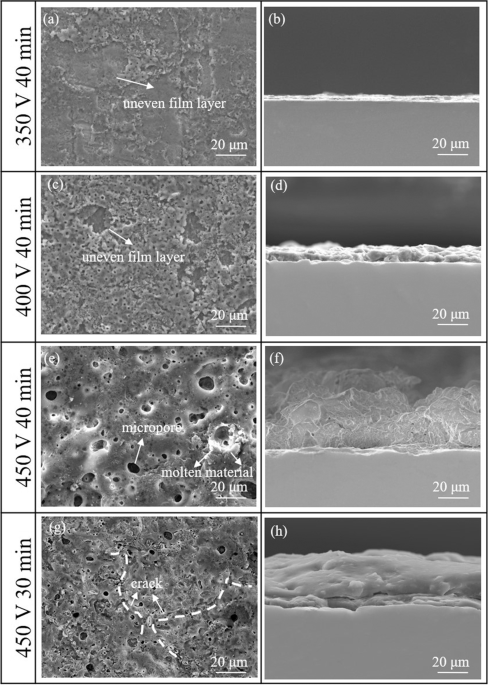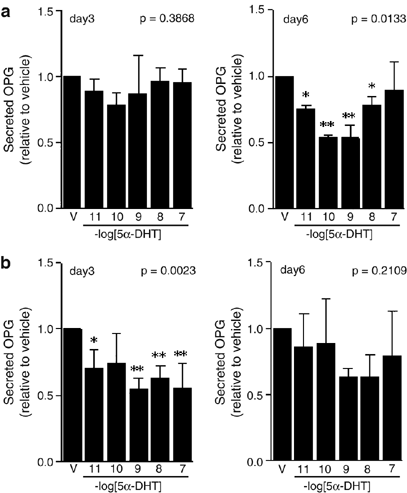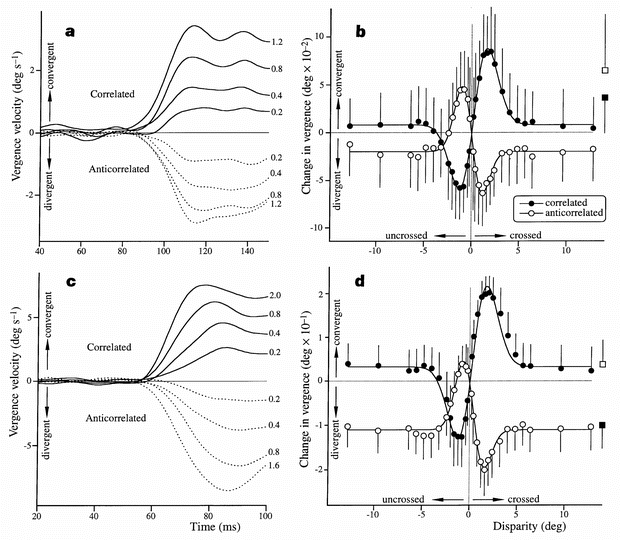
- Select a language for the TTS:
- UK English Female
- UK English Male
- US English Female
- US English Male
- Australian Female
- Australian Male
- Language selected: (auto detect) - EN
Play all audios:
ABSTRACT Primates use vergence eye movements to align their two eyes on the same object and can correct misalignments by sensing the difference in the positions of the two retinal images of
the object (binocular disparity). When large random-dot patterns are viewed dichoptically and small binocular misalignments are suddenly imposed (disparity steps), corrective vergence eye
movements are elicited at ultrashort latencies1,2. Here we show that the same steps applied to dense anticorrelated patterns, in which each black dot in one eye is matched to a white dot in
the other eye, initiate vergence responses that are very similar, except that they are in the opposite direction. This sensitivity to the disparity of anticorrelated patterns is shared by
many disparity-selective neurons in cortical area V1 (ref. 3), despite the fact that human subjects fail to perceive depth in such stimuli4,5. These dataindicate that the vergence eye
movements initiated at ultrashort latencies result solely from locally matched binocular features, and derive their visual input from an early stage of cortical processing before the level
at which depth percepts are elaborated. Access through your institution Buy or subscribe This is a preview of subscription content, access via your institution ACCESS OPTIONS Access through
your institution Subscribe to this journal Receive 51 print issues and online access $199.00 per year only $3.90 per issue Learn more Buy this article * Purchase on SpringerLink * Instant
access to full article PDF Buy now Prices may be subject to local taxes which are calculated during checkout ADDITIONAL ACCESS OPTIONS: * Log in * Learn about institutional subscriptions *
Read our FAQs * Contact customer support SIMILAR CONTENT BEING VIEWED BY OTHERS A COVERED EYE FAILS TO FOLLOW AN OBJECT MOVING IN DEPTH Article Open access 26 May 2021 COGNITIVE
PENETRABILITY OF SCENE REPRESENTATIONS BASED ON HORIZONTAL IMAGE DISPARITIES Article Open access 25 October 2022 LAWFUL KINEMATICS LINK EYE MOVEMENTS TO THE LIMITS OF HIGH-SPEED PERCEPTION
Article Open access 08 May 2025 REFERENCES * Busettini, C., Miles, F. A. & Krauzlis, R. J. Short-latency disparity vergence responses and their dependence on a prior saccadic eye
movement. _J. Neurophysiol._ 75, 1392–1410 (1996). Article CAS Google Scholar * Busettini, C., Miles, F. A. & Krauzlis, R. J. Short-latency disparity vergence responses in humans.
_Soc. Neurosci. Abstr._ 20, 1403 (1994). Google Scholar * Cumming, B. G. & Parker, A. J. Responses of primary visual cortical neurons to binocular disparity without depth perception.
_Nature_ 389, 280–283 (1997). Article ADS CAS Google Scholar * Julesz, B. Binocular depth perception of computer-generated patterns. _Bell System Tech. J._ 39, 1125–1162 (1960). Article
Google Scholar * Cogan, A. I., Lomakin, A. J. & Rossi, A. F. Depth in anticorrelated stereograms: Effects of spatial density and interocular delay. _Vision Res._ 33, 1959–1975 (1993).
Article CAS Google Scholar * Bishop, P. O. & Pettigrew, J. D. Neural mechanisms of binocular vision. _Vision Res._ 26, 1587–1600 (1986). Article CAS Google Scholar * Ohzawa, I.,
DeAngelis, G. C. & Freeman, R. D. Stereoscopic depth discrimination in the visual cortex: neurons ideally suited as disparity detectors. _Science_ 249, 1037–1041 (1990). Article ADS
CAS Google Scholar * Qian, N. Computing stereo disparity and motion with known binocular properties. _Neural Computat._ 6, 390–404 (1994). Article Google Scholar * Parker, A. J. &
Cumming, B. G. Local vs global stereoscopic matching in neurons of cortical area V1. _Invest. Ophthalmol. Vis. Sci._ 37, S424 (1996). Google Scholar * Collewijn, H. & Erkelens, C. J. in
_Eye Movements and their Role in Visual and Cognitive Processes_(ed. Kowler, E.) 213–261 (Elsevier, Amsterdam, (1990). Google Scholar * Judge, S. J. in _Vision and Visual Dysfunction, 8:
Eye Movements_(ed. Carpenter, R. H. S.) 157–172 (Macmillan, London, (1991). Google Scholar * Rashbass, C. & Westheimer, G. Disjunctive eye movements. _J. Physiol. (Lond.)_ 159, 339–360
(1961). Article CAS Google Scholar * Poggio, G. F. & Fischer, B. Binocular interaction and depth sensitivity in striate and prestriate cortex of behaving rhesus monkey. _J.
Neurophysiol._ 40, 1392–1405 (1977). Article CAS Google Scholar * Poggio, G. F. Mechanisms of stereopsis in monkey visual cortex. _Cerebr. Cort._ 5, 193–204 (1995). Article CAS Google
Scholar * Trotter, Y., Celebrini, S., Stricanne, B., Thorpe, S. & Imbert, M. Neural processing of stereopsis as a function of viewing distance in primate visual cortical area VI. _J.
Neurophysiol._ 76, 2872–2885 (1996). Article CAS Google Scholar * Mitchell, D. E. Properties of stimuli eliciting vergence eye movements and stereopsis. _Vision Res._ 10, 145–162 (1970).
Article CAS Google Scholar * Cumming, B. G. & Judge, S. J. Disparity-induced and blur-induced convergence eye movement and accommodation in the monkey. _J. Neurophysiol._ 55, 896–914
(1986). Article CAS Google Scholar * Westheimer, G. & Mitchell, D. E. The sensory stimulus for disjunctive eye movements. _Vision Res._ 9, 749–755 (1969). Article CAS Google Scholar
* Regan, D., Erkelens, C. J. & Collewijn, H. Necessary conditions for the perception of motion in depth. _Invest. Opthalmol. Vis. Sci._ 27, 584–597 (1986). CAS Google Scholar *
Busettini, C., Miles, F. A., Schwarz, U. & Carl, J. R. Human ocular responses to translation of the observer and of the scene: dependence on viewing distance. _Exp. Brain Res._ 100,
484–494 (1994). Article CAS Google Scholar * Fuchs, A. F. & Robinson, D. A. Amethod for measuring horizontal and vertical eye movement chronically in the monkey. _J. Appl. Physiol._
21, 1068–1070 (1966). Article CAS Google Scholar Download references ACKNOWLEDGEMENTS G.S.M. was supported by La Fondation pour la Recherche Medicale (France). AUTHOR INFORMATION AUTHORS
AND AFFILIATIONS * Laboratory of Sensorimotor Research, National Eye Institute, National Institutes of Health, Bethesda, 20892, Maryland, USA C. Busettini & F. A. Miles * Centre de
Recherche en Neurosciences Cognitives, Centre National de la Recherche Scientifique, 13402, Marseille, France G. S. Masson Authors * G. S. Masson View author publications You can also search
for this author inPubMed Google Scholar * C. Busettini View author publications You can also search for this author inPubMed Google Scholar * F. A. Miles View author publications You can
also search for this author inPubMed Google Scholar CORRESPONDING AUTHOR Correspondence to F. A. Miles. RIGHTS AND PERMISSIONS Reprints and permissions ABOUT THIS ARTICLE CITE THIS ARTICLE
Masson, G., Busettini, C. & Miles, F. Vergence eye movements in response to binocular disparity without depth perception. _Nature_ 389, 283–286 (1997). https://doi.org/10.1038/38496
Download citation * Received: 10 February 1997 * Accepted: 27 June 1997 * Issue Date: 18 September 1997 * DOI: https://doi.org/10.1038/38496 SHARE THIS ARTICLE Anyone you share the following
link with will be able to read this content: Get shareable link Sorry, a shareable link is not currently available for this article. Copy to clipboard Provided by the Springer Nature
SharedIt content-sharing initiative



